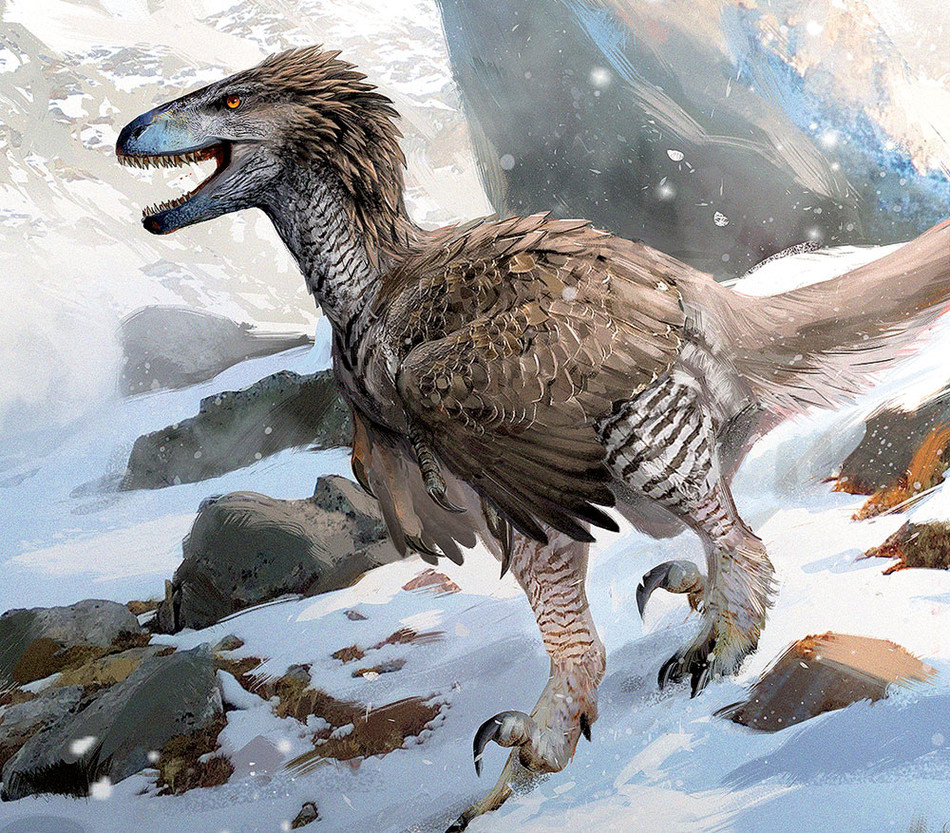We tend to think of dinosaurs as living in tropical rainforests, and for good reason — the Triassic and Jurassic periods in which they came to rule the planet were generally hot and steamy, with jungles covering much of the landscape.
But a new study by Columbia researchers in Science Advances suggests that some of the earliest dinosaurs could also tolerate cold weather, which may have given them an evolutionary advantage when the earth’s climate occasionally fluctuated. The evidence? Numerous dinosaur footprints recently discovered in northern China in layers of rock that also contain geological signatures of ice.
“This is the first empirical evidence that dinosaurs endured freezing temperatures for prolonged periods, which could have major implications for our understanding of their behavior and evolution,” says Paul Olsen, a geologist and paleontologist at Columbia’s Lamont-Doherty Earth Observatory and the lead author of the paper.
The newly discovered footprints are from a variety of birdlike dinosaurs and date from between 206 million and 193 million years ago. Olsen and his colleagues found them in China’s Junggar Basin desert, which at the time the dinosaurs lived was situated on the northern edge of the supercontinent Pangaea, well above the Arctic Circle. Other dinosaur fossils have been found in such northern latitudes before, but until now scientists were uncertain if any dinosaurs had ever endured truly frigid conditions, because when they roamed the earth, even the polar regions were fairly temperate. “The planet had no ice caps back then, and forests grew all the way up to the North Pole,” Olsen says. “So we weren’t sure if dinosaurs had ever seen snow or ice. Now we know they did. The geological evidence suggests that the climate here was probably similar to what the northeastern US now experiences.”
Olsen says that his team’s study adds to a growing body of research that suggests dinosaurs were more complex and adaptable than we typically imagine. Fossils unearthed in recent years show that many non-avian dinosaurs, including iconic beasts like tyrannosaurids, were covered in feathers, probably for insulation, he notes. And studies have suggested that dinosaurs were likely warm-blooded, or capable of regulating their body temperature metabolically, which would have provided additional protection against the cold. Olsen says that these traits would have served dinosaurs well on a planet that was extraordinarily hot overall by enabling them to avoid the tropics, with their extreme and unpredictable climatic patterns, in favor of temperate zones, where despite having to contend with seasonal winters they would have found more consistent food sources.
“We can tell from the fossil record that herbivores in particular loved the higher latitudes, where they would have munched on the leaves of conifers, ferns, and ginkgo trees all year round,” he says. “Many carnivores lived there too.”
In the new study, Olsen and his coauthors, who include fellow Columbia geologists Clara Chang, Dennis Kent ’74GSAS, and Sean Kinney ’21GSAS, argue that the dinosaurs’ tolerance for chilly temperatures may have been the secret to their nearly 150-million-year reign as the planet’s dominant land animals, enabling them to survive a major extinction event that occurred at the end of the Triassic period. At that time, convulsions of volcanic activity that accompanied the breakup of Pangaea spewed enormous amounts of gas into the earth’s atmosphere, and three-quarters of the world’s land and marine species vanished soon thereafter. The dinosaurs survived, and scientists have long debated why. Traditionally, paleontologists have thought that dinosaurs were able to withstand a sudden increase in atmospheric carbon dioxide and rising temperatures because they were well-suited to tropical climes. But the Columbia scientists offer a different hypothesis: they say that a haze of highly reflective sulfate aerosols emitted into the sky may have had a temporary cooling effect, which dinosaurs, with their feathers and sophisticated metabolisms, were unusually well-prepared for.
“Volcanic eruptions may have brought freezing temperatures to the tropics, which is where many of the extinctions of big, naked, un-feathered vertebrates seem to have occurred,” says Kent. “Whereas our fine feathered friends who were acclimated to cold temperatures did OK.”



